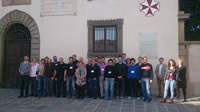From magma ascent to ash generation: investigating volcanic conduit processes by integrating experiments, numerical modeling, and observations
Polacci M., M. de’ Michieli Vitturi, F. Arzilli, M.R. Burton, L. Caricchi, B.B. Carr, M. Cerminara, C. Cimarelli, A.B. Clarke, S. Colucci, A. Costa, W. Degruyter, T. Druitt, S. Engwell, T. Esposti Ongaro, D. Giordano, L. Gurioli, B. Haddadi, J. Evan Kendrick, U. Kueppers, A. Lamur, Y. Lavallée, E. LLewellin, H.M. Mader, N. Metrich, C. Montagna, A. Neri, E. Rivalta, G. Saccorotti, F. Sigmundsson, L. Spina, J. Taddeucci (2017).
Annals of Geophysics, 60/6, doi: 10.4401/ag-7449.
Abstract
Processes occurring in volcanic conduits, the pathways through which magma travels from its storage region to the surface, have a fundamental control on the nature of eruptions and associated phenomena. It has been well established that magma flows, crystallizes, degasses, and fragments in conduits, that fluids migrate in and out of conduits, and that seismic and acoustic waves are generated and travel within conduits. A better understanding of volcanic conduits and related processes is of paramount importance for improving eruption forecasting, volcanic hazard assessment and risk mitigation. However, despite escalating advances in the characterization of individual conduit processes, our understanding of their mutual interactions and the consequent control on volcanic activity is still limited. With the purpose of addressing this topic, a multidisciplinary workshop led by a group of international scientists was hosted from 25 to 27 October 2014 by the Pisa branch of the Istituto Nazionale di Geofisica e Vulcanologia under the sponsorship of the MeMoVolc Research Networking Programme of the European Science Foundation. The workshop brought together the experimental, theoretical, and observational communities devoted to volcanological research. After 3 days of oral and poster presentations, breakout sessions, and plenary discussions, the participants identified three main outstanding issues common to experimental, analytical, numerical, and observational volcanology: unsteadiness (or transience), disequilibrium, and uncertainty. A key outcome of the workshop was to identify the specific knowledge areas in which exchange of information among the sub-disciplines would lead to efficient progress in addressing these three main outstanding issues. It
was clear that multidisciplinary collaboration of this sort is essential for progressing the state of the art in understanding of conduit magma dynamics and eruption behavior. This holistic approach has the ultimate aim to deliver fundamental improvements in understanding the underlying processes generating and controlling volcanic activity.
http://www.annalsofgeophysics.eu/index.php/annals/article/view/7449


